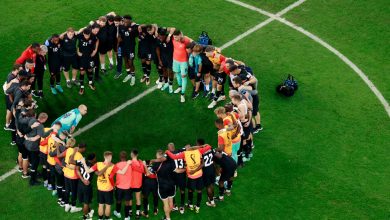“He is fighting for his first gold medal. I’m trying to defend my territory.”

Karsten Warholm remembers two things about the moment everything changed — in that magical race, in his career and in his life.
This was just before the last hurdle and the mad 30-meter dash to the finish of the 400-meter hurdles at the Tokyo Olympics. He glimpsed his rival, Rai Benjamin, suddenly closing on his left shoulder. Exhausted and running out of oxygen, he began to see stars. And then, in an instant, Benjamin was gone, and Warholm was crossing the finish line to win the gold medal for Norway, a rarity for a country far better known for winter sports, salmon and oil wealth.

A lot of power goes into Karsten Warholm’s roar.Credit…Jewel Samad/Agence France-Presse — Getty Images
Both Warholm and Benjamin broke the previous world record that day, turning their rematch Tuesday night into a can’t-miss event at this week’s World Athletics Championships at Hayward Field in Eugene, Ore. Warholm shook off concerns about a recent hamstring tear and blazed into the finals along with Benjamin on Sunday, when both won their semifinal heats. Together, they are giving 400-meter hurdles a stature it has not had since Edwin Moses was cruising to 122 consecutive victories in the race in the 1980s.
For all his stardom, though, Moses did not have a singular rival throughout his career the way the 26-year-old Warholm does in Benjamin, who is 24. Warholm and Benjamin also finished one-two, and in the same order, at the last world championships. While they are friendly off the track, theirs is now a duel as intense as the Viking roar Warholm lets out as he beats his upper chest, just below his shoulders, before loading into the blocks to start each race. It’s a rivalry the sport desperately needs.
“He trains in the U.S.; I train in Norway. He’s Nike; I’m Puma,” Warholm said in a recent interview from his home in Oslo. “He is fighting for his first gold medal. I’m trying to defend my territory.”
Now, about that roar and chest thump.
Warholm said the ritual began in training in Oslo. Because the country is so small (roughly 5.4 million people) and track is something of an afterthought, well behind Nordic skiing, he has never had any competition. His coach and a few female quarter-milers are the extent of his daily company in training.
That meant he had to find a way to juice his adrenaline before a training heat. He tried the roar and chest thump one day and liked it.
He used to whack himself a little lower on his torso. Then, a trainer informed him that pounding on his heart just before a quarter-mile sprint was a terrible idea. He listened and raised the point of contact but continued to pound. The sound of his fist hitting his flesh can echo through the lower bowl of a track stadium.
“There is a lot of power that goes into it,” Warholm said.
Roars and chest thumps may not be enough for Warholm to overcome his latest obstacle, though. In June, at his opening 400-meter-hurdles race of the season, Warholm pulled up with a hamstring injury after the first hurdle. Since then, he and his coach, Leif Alnes, have thought about little else except trying to be healthy for the world-championship rematch with Benjamin.
When Warholm pulled up in that race in Rabat, Morocco, Alnes was relieved that his prized student did not crumple to the ground, which often happens with a severe hamstring tear. That said, the 400-meter hurdles is basically a sprint, and in sprinting, 99 percent healthy is not enough. If Warholm isn’t at 100 percent, he won’t run.
“I always say, if you don’t have time to do it the right way right now, then when will you have time,” Alnes said in a recent interview. “We have to be wise. This is not a decision that can be based on emotions.”
Warholm dabbled with soccer and winter sports as a child growing up near Norway’s western coast, in the fjords, but he emerged as a track star in his midteens and never looked back. He was initially a decathlete. His two best events were the 400 meters and the 110-meter hurdles. Alnes, a longtime coach with Norway’s track and field federation, told him that combining those two events would be the fastest path to the Olympics.
He was right. Warholm qualified in the 400-meter hurdles for the 2016 Rio Olympics, where he failed to make the final but recorded the 10th fastest time in the semis. The next year, in London, he won his first world championship at just 21 years old. Track experts said it was a fluke, since Warholm won with the slowest winning time at a world championship.
No one is calling him a fluke now.
Moses said Warholm’s life and training regimen in Norway, far away from distractions and his competition, most likely help him.
“Rivals propel your knowledge and your training,” Moses said in an interview. “I knew how good a runner Harald Schmid was, and that by the time I got up in California, he had put in a full day’s work and was done in West Germany.”
Warholm met Moses years ago, at a track meet in Oslo, and Moses has long been an influence on Warholm’s career. Moses, who has a degree in physics and is considered the Albert Einstein of the 400-meter hurdles, had been among the first competitors in the event to make just 13 steps between the hurdles.
Previously, 14 was the standard. Now nearly everyone uses 13, including Warholm, though at just under 6-foot-2, he is several inches shorter than many of his top competitors, making it more difficult for him.
Heading into Tokyo, the showdown with Benjamin figured to be special. Benjamin had come within five-hundredths of a second of the world record at the U.S. Olympic Trials in late June. The mark had stood for nearly 29 years. Then Warholm broke it in July by eight-hundredths. Both assumed winning the gold medal would require breaking it again.
Warholm likes to start quickly, stretching the gap between himself and the runner on his left while making the gap between himself and the runner on his right disappear. Tokyo was no exception.
Within 100 meters, he had passed Alison dos Santos, the Brazilian champion. For a moment, Warholm thought he might have started too fast. But there was no turning back.
As he came around the last turn, he glimpsed Benjamin closing on his left shoulder. It was all going to come down to the last hurdle. Warholm had a clean pass when he needed it most. Benjamin missed his mark ever so slightly.
“I saw him, and then I didn’t see him anymore,” he said.
He pumped his arms and sprinted for the finish. He looked up at the scoreboard, saw his time and grabbed his head. In high-tech spikes on one of the fastest tracks ever built, he ran 45.94, three-quarters of a second faster than his previous record but only a quarter of a second ahead of Benjamin.
It was a rare gold medal in running for Norway and the country’s first since 1996, with perhaps more to come now that people see what is possible.
“It’s like the rock that gets thrown into the water and the waves go really far out if it is big enough,” Alnes said.
Four days later, his fellow Norwegian Jakob Ingebrigtsen won gold in the 1,500 meters, turning the two men into icons in their country on the level of its skiers.
Warholm spends his free time building ornate models out of Legos. He has one of the Coliseum in Rome and another of Hogwarts, from Harry Potter, and London Bridge. It’s a release, he said, something to do besides running and looking at a screen. He loves to build model sports cars, too. He has built a model Lamborghini, a Bugatti and a McLaren. He drives a Porsche Taycan, an electric sports car.
When he is having a bad day, he pulls out his phone and searches for a video of his race from last year’s Olympics. He’s done this at least 15 times. It always works.
“Forever, that will be my most important race,” he said. “Never again will I have the chance to win my first Olympic gold medal.”





